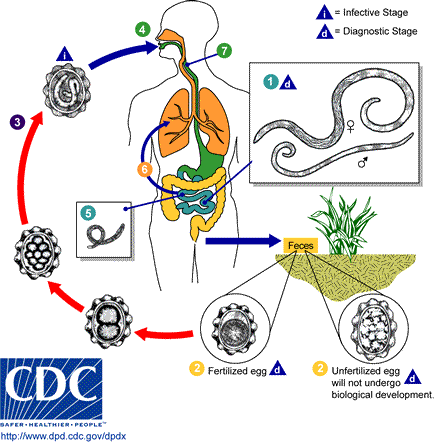Ascariasis
Ascariasis is a debilitating human disease caused by the roundworm Ascaris lumbricoides; other species of Ascaris are parasitic in domestic animals (see Nematode). Perhaps as many as one quarter of the world's people are infected, but ascariasis is particularly prevalent in tropical regions and in areas of poor hygiene. more...
Infection occurs through ingestion of food contaminated with fecal matter containing Ascaris eggs. The larvae hatch, burrow through the intestine, reach the lungs, and finally migrate up the respiratory tract. From there they are then reswallowed and mature in the intestine, growing up to 30 cm (12 in.) in length and anchoring themselves to the intestinal wall.
Infections are usually accompanied by inflammation, fever, and diarrhea, and serious problems may develop if the worms migrate to other parts of the body.
Prevalence
Roughly 1.5 billion individuals are infected with this worm1. Ascariasis is endemic in the United States including Gulf Coast and Ozark Mountains; in Nigeria and in Southeast Asia. One study indicated that the prevalence of ascariasis in the United States at about 4 million (2%). In a survey of a rural Nova Scotia community, 28.1% of 431 individuals tested were positive for Ascaris, all of them being under age 20, while all 276 tested in metropolitan Halifax were negative2.
Deposition of ova (eggs) in sewage hints at the degree of ascariasis incidence. A 1978 study showed about 75% of all sewage sludge samples sampled in United States urban catchments contained Ascaris ova, with rates as high as 5 to 100 eggs per liter. In Frankfort, Indiana, 87.5% of the sludge samples were positive with Ascaris, Toxocara, Trichuris, and hookworm. In Macon, Georgia, one of the 13 soil samples tested positive for Ascaris. Municipal wastewater in Riyadh, Saudi Arabia detected over 100 eggs per liter of wastewater 3 and in Czechoslovakia was as high as 240-1050 eggs per liter 4.
Ascariasis sources can often be measured by examining food for ova. In one field study in Marrakech, Morocco, where raw sewage is used to fertilize crop fields, Ascaris eggs were detected at the rate of 0.18 eggs/kg in potatoes, 0.27 eggs/kg in turnip, 4.63 eggs/kg in mint, 0.7 eggs/kg in carrots, and 1.64 eggs/kg in radish5. A similar study in the same area showed that 73% of children working on these farms were infected with helminths, particularly Ascaris, probably as a result of exposure to the raw sewage.
Life cycle
First appearance of eggs in stools is 60-70 days. In larval ascariasis, symptoms occur 4-16 days after infection. The final symptoms are gastrointestinal discomfort, colic and vomiting, fever; observation of live worms in stools. Some patients may have pulmonary symptoms or neurological disorders during migration of the larvae. However there are generally few or no symptoms. A bolus of worms may obstruct the intestine; migrating larvae may cause pneumonitis and eosinophilia.
Read more at Wikipedia.org



